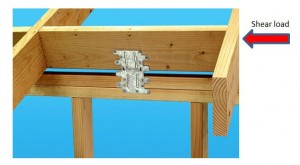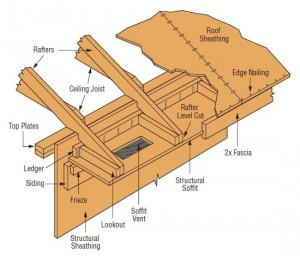Blocking or boundary member?
In my experience traveling across the country observing wood-framed construction, it was apparent that east of the Rocky Mountains, structural wood members in-line with supporting walls between roof framing cease to be installed. Some may call these wood members blocking and deem them as optional. And often in a humid environment, installation of these members may be ardently resisted in order to provide ample attic ventilation and prevent mold growth. It is important, however, to understand that this blocking creates the structural boundary members for the roof diaphragm and it is not optional.
Tabulated allowable diaphragm lateral design loads contained in the building code, are based on testing of unblocked and blocked diaphragms (structural wood members used at intermediate sheathing edges to increase the shear load in the diaphragm). In all cases a boundary member around the perimeter of the diaphragm, where the shear is the highest, was utilized. The boundary member in these tested assemblies was a minimum 2x structural member that collected the load from the diaphragm through the fasteners in the edge of the diaphragm. When a boundary member is missing, what other key element is also missing? That’s right, the fasteners! If a diaphragm boundary member and consequently sheathing fasteners are omitted, a weakened and unknown allowable roof diaphragm lateral load will exist.
Example
If the roof framing is spaced at 24 inches on center in the picture below, what is the fastener spacing in the direction of the shear load if there is no boundary member? Yep, pretty easy, 24 inches on center. So what is the diaphragm allowable load with fasteners spaced at 24 inches on center? The answer is unknown.

In addition to being a required structural member, the boundary member can be a big benefit when installed. There is an obvious direct connection between the roof diaphragm and lateral resisting system below (typically shearwalls) to transfer shear loads. Hurricane ties may be an alternative to transfer shear between the roof and wall, but the use of these connectors does not negate the need for the boundary member. Installing a boundary member will require additional detailing to attain the needed ventilation without compromising the structural integrity of the roof diaphragm.
Ventilation
Adequate attic ventilation can be developed through other detailing like holes and screens in the boundary member, orienting every third member horizontal, or gable end vents; but cannot be a reason for eliminating the diaphragm boundary member.
One possible method to eliminate the boundary member in-line with the wall below may be to soffit the eaves and provide a structural fascia board that will receive the diaphragm fasteners. Proper detailing, like shown below, and a structural soffit will be required to adequately transfer the shear in this method.
What are your thoughts? Let me know in the comments.
– Paul
What are your thoughts? Visit the blog and leave a comment!



Excellent clarification of the function of blocking between rafters.
Herbert Birthelmer,P.E.
That was a great article. I had a client that was an electrical engineer, and told me that he use to teach statics at a university and he didn’t think that he needed to have blocking between the trusses on his ICF garage. I wish I could have had that article to send him, maybe that would have changed his mind. Ultimately I had to refuse to sign-off on his building.
Simpson has the F-RBC flier available online at http://www.strongtie.com/ftp/fliers.F-RBC10.pdf that expands on code requirements for blocking (or structural fascia and detailing) with good information on attic ventilation as well
Excellent, I’m sharing w/ our helpdesk, I’ve taken a number of these inquiries.
Tom Skaggs (APA)
By the way, what load did it take to explode the bowling ball.
Thanks Tom.
The bowling ball in the video exploded at 23 kips, so your guess was right on.
Complete and utter WAG…
Perfect. About time this tune got some air play. Guess I’m not alone out there!
I agree
that the boundary blocking and nailing and out west here we do put the blocking
in but we rarely get the roof sheathing nailed to it or the blocking attached
to the wall plate. And what Building Official ever looks for it. The tar paper
is already on when he visits.
On the
ventilation issue, it is a critical one and does need to be addressed and it
should be address by the engineers, not the architects or building
officials. Holes in the middle of the
blocking will not work the way the Code requires the insulation to be installed
at the eaves. I do a lot of forensic
investigation and I will tell you that gable end venting alone does not solve
the issue nor does just ridge vent. That
low eave ventilation really makes a different in climate where the freeze/thaw
is present. So a solution we (not just
my Firm) have used is to add 2 “V” notches 3” wide cut with 45 degree sides evenly
spaced in the top of the top of the blocking.
I have seen some call for 3 notches.
It takes a little more care on the roof sheathing nailer to get it
properly nailed off outside of the notches but it can be done
successfully. If you think about it, for
3 notches it would take 9” out of 22.5” leaving 13.5” of contact with the
sheathing in 4 sections of over 3” each ((3 notches + 4 Surfaces)*3”=21”<22.5”
gives 1.5” of play) which can take 1 nail each for a spacing of roughly 6” o.c. With 2 notches you can roughly get 4” o.c. If
one is concerned about splitting one can specify LSL Blocking.
Just some
thought from the field, would like to hear your thoughts on this idea or other
ways of solving the issue of ventilation.
We generally use the structural fascia board method.
Your H1 hurricane ties are the only commonly used tie that has a good horizontal F1 value.
Maybe if you increased the gage and added some nails you could come out with a H1A version that had uplift values equal or better than H2.5A.
If the overhang is not too long the fascia board should be close enough to the support to prevent twisting of the rafter or truss unless the diaphragm shear forces are very large.
On method to increase the diaphragm shear transfer is to nail a 2x flatwise on top of the sill plate (cut tight to fit) between the roof members.
Do most engineers anchor the blocking to the top of wall also, or do they take the load shear through the truss connector?
Nice article. Has anyone ever seen a roof fail because of missing boundary members, though?